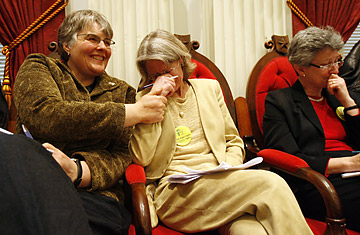
Gay marriage advocate Beth Robinson, center, holds back tears following the passage of a gay marriage bill in Montpelier, Vt., Tuesday, April 7, 2009.
Although our three-branch system of government is hallowed in the Constitution itself, many Americans have always considered decisions delivered by the third branch, the judiciary, to be less legitimate than those voted on in the legislative sessions of the first branch. After all, if the people really hate what the first branch does, they can trim that wayward twig in the next election. With judges—well, there's little to be done, except perhaps for hoping for a reconsideration by different judges sometime in the future.
That's one reason the U.S. occasionally finds itself threatening the right of women to control their reproductive decisions: Roe v. Wade was a court ruling, not the vote of an elected body, and so the vote of one new Supreme Court justice—a single person—could undo it. Unjust as it may seem, abortion rights in this country will always be tainted with Roe's undemocratic blemish. (See TIME's graphic "New Fronts in the Abortion Battle.")
Until this week, critics of so-called gay marriage used that same undemocratic argument to try to discredit the new right, which is why the Vermont legislature's April 7 vote to legalize marriage for gay couples mattered so much: it was the first time in U.S. history that a first-branch institution, one that has to face voters in short order, actually granted equal marriage rights. (The California legislature has twice voted for marriage equality, but advocates couldn't muster enough votes to override Gov. Arnold Schwarzenegger's vetoes). Lesbian and gay Americans, who will celebrate the 40th anniversary of the Stonewall riots in June, have a long history of emerging from shadows, and now they have shaken off the idea that they must always cower behind judges' cloaks to get the equality they deserve.
And yet the very language we use to describe the Vermont vote cheapens the historic nature of the moment. On the afternoon of April 7, the headlines on the websites of several publications—including the Washington Post, Fox News, USA Today, and Chicago Sun-Times—were identical: "Vermont Legalizes Gay Marriage." (Read "A Gay-Marriage Solution: End Marriage?")
Wrong. Vermont (and the District of Columbia, whose council voted unanimously that same day to provide equal rights to all couples married outside D.C. regardless of gender composition) was not creating a new institution called "gay marriage." Rather, it was correcting a historical, legal and moral error, one that restricted the institution of marriage to couples that possessed a certain arrangement of genitalia.
There is no such thing as gay marriage. There is equality, and Vermont's elected representatives will be remembered as the first in history to recognize it.
